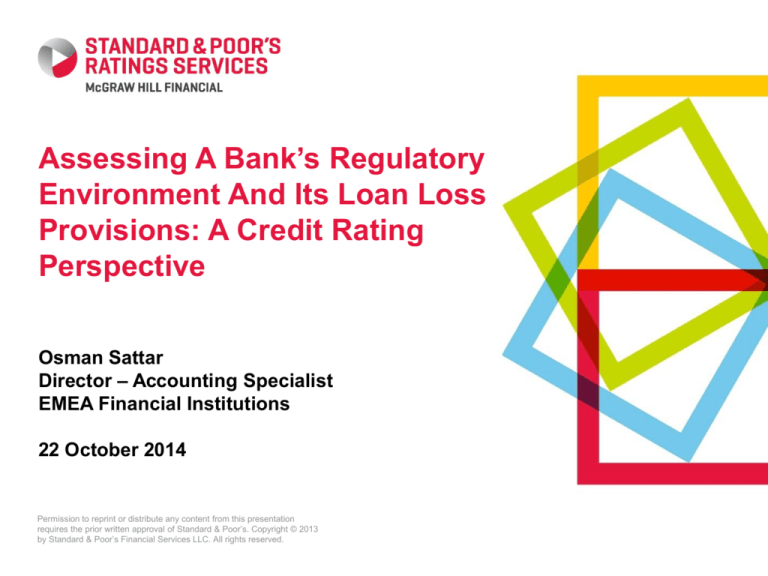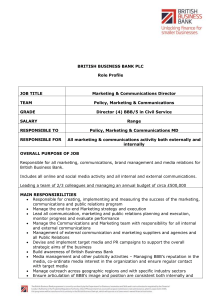
Assessing A Bank’s Regulatory
Environment And Its Loan Loss
Provisions: A Credit Rating
Perspective
Osman Sattar
Director – Accounting Specialist
EMEA Financial Institutions
22 October 2014
Permission to reprint or distribute any content from this presentation
requires the prior written approval of Standard & Poor’s. Copyright © 2013
by Standard & Poor’s Financial Services LLC. All rights reserved.
Agenda
Bank Ratings Framework:
•
Banking Industry Country Risk Assessment
• Economic Risk
• Industry Risk
•
Bank-Specific Factors
• Business Position
• Capital & Earnings
• Risk Position
• Funding & Liquidity
• External Factors
• Group Support
• Government Support
IFRS 9: Could Ballooning Loss Reserves Deflate Bank Capital Ratios?
Appendices
2
Bank Ratings Framework
Bank Ratings Framework
Standard and Poor’s bank ratings
framework is comprised of:
• Macro factors – the Banking
Industry Country Risk (BICRA)
assessment.
• Bank-specific factors:
•
•
•
•
Business position;
Capital and earnings;
Risk position; and
Funding and liquidity.
• External support:
• Group support (from parent and/or other
entities in the group); and
• Extraordinary government support.
4
Bank Ratings Framework – BICRA
• BICRA: The starting point for all
bank ratings in a country.
• Scored on a scale from 1 (lowest risk) to 10
(highest risk).
• Comprises two main areas of (macro)
analysis - economic risk and industry risk.
• BICRA economic risk considers:
• Economic resilience;
• Economic imbalances;
• Credit risk in the economy.
• BICRA industry risk considers:
• Institutional framework;
• Competitive dynamics;
• System-wide funding
5
Current BICRA, Economic Risk And Industry Risk Scores
Data as at 8 October 2014
6
BICRA: Credit Risk - Lending And Underwriting Standards
Are lending standards “moderately
conservative,” “relaxed,” or
“aggressive”? E.g:
• Household lending risk
• Share of new residential mortgage
lending that is above 80% LTV.
• Average indexed LTV for residential
mortgages.
• Are underwriting standards based on
multiple factors, or only a single one?
• Share of non-prime mortgage lending?
• Corporate lending risk
• Concentrations in cyclical / vulnerable
sectors (e.g. commodities, shipping).
• Extent of CRE construction &
development lending.
7
BICRA: Institutional Framework – Banking Regulation And
Supervision, Regulatory Track Record
Ability and track record of
regulators in maintaining financial
stability - e.g:
• Scope of regulation
• Gaps in regulatory coverage?
• Compliance with international standards?
• Effectiveness of supervision
• Single supervisor / close co-operation across
supervisors?
• Systematic oversight (e.g. close and frequent
monitoring) of banks?
Regulatory track record:
• Past success in preventative measures
• Identifying problems at an early stage
8
BICRA: Institutional Framework – Governance And
Transparency
Good corporate governance lowers
the risk of a banking system.
• Financial reporting:
• Frequency and timeliness
• Quality and standardization
• Auditing rules
• The BICRA’s economic risk &
industry risk scores determine a
bank's Anchor Stand Alone Credit
Profile (Anchor SACP)
• The Anchor SACP is the starting point in
assigning the rating. It’s adjusted up or down
the ratings scale after taking into account a
bank's specific strengths and weaknesses in
the bank-specific factors.
9
From The BICRA To The Anchor SACP - Examples
• Poland:
Determining The Anchor SACP From Economic Risk And Industry Risk
Economic risk
Industry
risk
1
2
3
4
5
6
1
a
a
a-
bbb+
bbb+
bbb
2
a
a-
a-
bbb+
bbb
bbb
bbb-
3
a-
a-
bbb+
bbb+
bbb
bbb-
bbb-
bb+
4
bbb+
bbb+
bbb+
bbb
bbb
bbb-
bb+
bb
bb
5
bbb+
bbb
bbb
bbb
bbb-
bbb-
bb+
bb
bb-
b+
6
bbb
bbb
bbb-
bbb-
bbb-
bb+
bb
bb
bb-
b+
bbb-
bbb-
bb+
bb+
bb
bb
bb-
b+
b+
bb+
bb
bb
bb
bb-
bb-
b+
b
bb
bb-
bb-
b+
b+
b+
b
b+
b+
b+
b
b
b-
7
8
9
10
Data correct as at 8 September 2014
10
7
8
9
10
• Economic Risk: 5
• Industry Risk: 5
Anchor SACP: bbb-
• Hungary:
• Economic Risk: 9
• Industry Risk: 7
Anchor SACP: b+
• Kazakhstan:
• Economic Risk: 8
• Industry Risk :8
Anchor SACP: bb-
• Ukraine:
• Economic Risk: 10
• Industry Risk :10
Anchor SACP: b-
Bank Ratings Framework – Bank-Specific Factors
Bank-specific factors consist of:
• Business position
• Business stability
• Concentration or diversity
• Management and corporate strategy
• Capital and earnings
• S&P’s measurements of capital (Total
Adjusted Capital, TAC) and risk-weighted
assets to compute projected Risk-Adjusted
Capital ratios (RAC ratios)
• Risk position
• Funding and liquidity
• The BICRA and bank-specific
factors determine the bank’s
stand-alone credit profile, SACP
11
Bank-Specific Factors Adjust The Anchor SACP To
Determine The SACP
• After the anchor SACP,
consideration of each of the
bank-specific factors can raise
or lower the anchor SACP by
one or more notches - or have
no effect in some cases (see
table).
• These conclusions are expressed using
specific rankings and descriptors.
• These rankings and descriptors, in turn,
determine the number of notches to
apply to the anchor SACP to determine
the level of a specific bank's SACP.
12
Bank-Specific Factors – Business Position
Business Position Subfactors And Indicators
Subfactors
Explanation
Indicators
Business
stability
The stability or
fragility of a bank's
franchise
Revenue stability, market
shares, and the customer base
Concentration
or diversity
The concentration or
diversification of
business activities
Contributions of different
business lines and
geographies to overall revenue
Management
and corporate
strategy
The quality of
management,
strategy, and
corporate
governance
Strategic positioning,
operational effectiveness,
financial management, and
governance and financial
policies
• Business position
measures the
strength of a
bank's business
operations.
• Business position is the
combination of specific
features of the bank's
business operations that
add to or mitigate its
industry risk score.
• Business position
has 3 subfactors:
• Business stability;
• Concentration or
diversity; and
• Management and
corporate strategy.
13
Bank-Specific Factors – Business Position (cont’d)
Business Position Assessment
Qualifier
What it means
Very Strong
A bank’s business operations make it better placed to withstand adverse operating conditions
than the industry risk score indicates.
Strong
A bank’s business operations make it somewhat less vulnerable to adverse operating
conditions than the industry risk score indicated.
Adequate
A bank’s business operations are representative of the industry risk score.
Moderate
A bank’s business operations make it more vulnerable to adverse operating conditions than
the industry risk score indicates.
Weak*
A bank’s business operations make it significantly more vulnerable to operating conditions
than the industry risk score indicates.
Very Weak
The industry risk score is not representative of a bank’s vulnerability to adverse operating
conditions. (This category applies only in exceptional circumstances.)
*The impact on the SACP is a deduction of two or three notches. Three notches applies only in the fragmented industries
with a large number of smaller banks that all have weaker-than average industry risk. Deducting two or three notches from
the SACP for a weak classification helps to differentiate such banks further.
14
Bank-Specific Factors – Capital & Earnings
• Capital and earnings measures a bank's ability to absorb losses. Our
analysis of capital and earnings comprises four steps:
•
•
•
•
Assessment of regulatory requirements;
Future risk-adjusted capital levels;
Quality of capital; and
Earnings capacity.
• S&P’s projected risk-adjusted capital (RAC) ratio is the most
important metric for our capital and earnings assessment:
• The RAC ratio compares a bank's capital to its risk-weighted assets (RWAs). Specifically, we use
a globally consistent measure of capital, total adjusted capital (TAC) and S&P RWAs.
15
Bank-Specific Factors – Risk Position
• The assessment of risk position serves to refine the view of a bank's
actual and specific risks beyond the conclusion arising from the
standard assumptions in the capital and earnings analysis.
• Those assumptions do not always reflect or adequately capture the specific risk characteristics of a
particular bank.
• The analysis described in risk position is similar to that traditionally applied to assess the asset
quality of a bank.
• Five areas are analyzed:
•
•
•
•
•
16
Growth and changes in its risk positions;
Risk concentrations or risk diversification;
Complexity;
Risks not covered by RACF; and
Loss experience and expectations.
Bank-Specific Factors – Risk Position: Estimating Credit
Losses
Standard & Poor's uses its own projection of credit losses for each
bank it rates in its ratings analysis. We factor:
• Our projected credit losses for each bank in our assessment of each
bank's SACP; and
• Our views about asset quality and the bank's relative capital position.
• S&P’s credit loss estimates are based on our calculation of loss given
default (LGD) for each relevant asset class for the banking system as
a whole.
• We apply the systemwide standard LGD calculations to all banks in a system. Yet, we realize that
LGDs may vary greatly from bank to bank because of differences in the quality of loan portfolios
and ability to recover losses. If we believe that these differences are significant, we factor them
together with other factors into our assessment of the risk position of each bank.
• Our LGD assumptions also take into account our assumptions about
the average loan-to-value ratio that banks demand when extending
credit, particularly to corporations and for residential mortgages.
17
Bank-Specific Factors – Funding & Liquidity
• The analysis of funding compares the strength and stability of a
bank's funding mix, according to several metrics, with the domestic
industry average.
• The liquidity analysis centers on a bank's ability to manage its
liquidity needs in adverse market and economic conditions and its
likelihood of survival over an extended period in such conditions. The
analysis is both absolute and relative to peers.
18
Bank-Specific Factors – Funding & Liquidity (cont’d)
Funding Assessment
Descriptor
What it means
Above
Average
A bank exhibits stronger funding metrics than the average for all banks in the
same country.
Average
A bank exhibits similar funding metrics than the average for all banks in the
same country.
Below
Average
A bank exhibits weaker funding metrics than the average for all banks in the
same country.
19
Bank Ratings Framework – External Support
Assessment of:
• Likelihood for future extraordinary government
support.
• Likelihood for future extraordinary group
support.
20
IFRS 9: Could Ballooning Loss
Reserves Deflate Bank Capital
Ratios?
Higher Credit Losses May Have A Meaningful Impact On
Bank Capital
• Moving to IFRS 9 will result in an
earlier recognition of credit losses
• Higher credit loss allowances decrease banks'
capital. All else being equal, our analysis suggests
that among the top 100 global banks we rate,
western European banks could see core tier 1 ratios
falling by an average of 53bps for each 10% rise in
reserves.
• The new rules changes could lead
some banks to shift loan product
strategies, e.g.
• Favoring shorter-duration loan products over
longer-term loan products to achieve a more
favorable accounting outcome.
• In extreme cases, bank management may decide to
curtail the underwriting of new loan products.
22
Impact On Core Tier 1 Ratios From Rising Credit Loss
Allowances For Top 100 Rated Banks, By Region
• For each 10%
rise in
allowances:
• Western European
banks' core tier 1
ratios fall by 53bps
on average;
• EEMEA: average
fall of 17bps;
• US: 12bps;
• Canada: 10bps;
• APAC: 16bps;
• LatAm: 35bps
23
Regional Differences Could Be Due To Many Factors
The differences in the magnitude of the capital impact across banks in
different regions result from a combination of factors, including:
• Differences in business models:
• There is generally a greater level of disintermediation in U.S. banks compared with European
banks, with the latter retaining a relatively larger proportion of loans on their balance sheets.
• Differences in asset write-off policies:
• Legal processes such as foreclosure tend to be slower in some jurisdictions (such as countries in
southern Europe), so it can take longer for impaired assets to be written off from the balance sheet.
Therefore, banks in such jurisdictions often carry high levels of provisioning against impaired
assets for a longer time.
24
The IFRS 9 Credit Loss Model Does Not Go Far Enough
IFRS 9 requires a dual-measurement approach
• Recognition of an initial (day 1) credit loss allowance
•
Represents 12 months of expected credit losses for all financial assets in the scope of the
model, updated at each reporting period.
• Recognition of lifetime expected credit losses
•
Only if and when management decides the credit risk of the financial asset has significantly
increased since its initial recognition.
• This means that, for assets that are performing as banks originally
expected - including the vast majority of most banks‘ loan portfolios the model would only reflect a portion of expected credit losses.
• The dual-measurement approach will also lead to inconsistencies
across banks
• Because the judgments bank managements apply about whether assets have experienced
significant increases in credit risk are likely to vary and may be subject to bias (e.g., where
management may be influenced by earnings targets).
25
Appendices:
- S&P Rating Scales
- BICRAs By Group And Country
- Selected S&P publications
Appendix: S&P Rating Scales
27
Appendix: BICRAs By Group And Country
Data as at 8 October 2014
28
Appendix: Selected S&P Publications
Research:
• Could Ballooning Loss Reserves From New Accounting Rules
Deflate Bank Capital Ratios? Sep. 9, 2014
• Banking Industry Country Risk Assessment Update: October 2014,
Oct 8, 2014
Criteria:
• Banks: Rating Methodology And Assumptions, Nov. 9, 2011
• Banking Industry Country Risk Assessment Methodology And
Assumptions, Nov. 9, 2011
29
Thank You
Osman Sattar
Director – Accounting Specialist, EMEA Financial Institutions
T: +44 (0)20 7176 7198
osman.sattar@standardandpoors.com
Permission to reprint or distribute any content from this presentation requires the prior written approval of
Standard & Poor’s. Copyright © 2013 by Standard & Poor’s Financial Services LLC. All rights reserved.
Copyright © 2013 by Standard & Poor’s Financial Services LLC. All rights reserved.
No content (including ratings, credit-related analyses and data, valuations, model, software or other application or output therefrom) or any part thereof (Content) may be modified,
reverse engineered, reproduced or distributed in any form by any means, or stored in a database or retrieval system, without the prior written permission of Standard & Poor’s
Financial Services LLC or its affiliates (collectively, S&P). The Content shall not be used for any unlawful or unauthorized purposes. S&P and any third-party providers, as well as their
directors, officers, shareholders, employees or agents (collectively S&P Parties) do not guarantee the accuracy, completeness, timeliness or availability of the Content. S&P Parties
are not responsible for any errors or omissions (negligent or otherwise), regardless of the cause, for the results obtained from the use of the Content, or for the security or
maintenance of any data input by the user. The Content is provided on an “as is” basis. S&P PARTIES DISCLAIM ANY AND ALL EXPRESS OR IMPLIED WARRANTIES,
INCLUDING, BUT NOT LIMITED TO, ANY WARRANTIES OF MERCHANTABILITY OR FITNESS FOR A PARTICULAR PURPOSE OR USE, FREEDOM FROM BUGS,
SOFTWARE ERRORS OR DEFECTS, THAT THE CONTENT’S FUNCTIONING WILL BE UNINTERRUPTED OR THAT THE CONTENT WILL OPERATE WITH ANY SOFTWARE
OR HARDWARE CONFIGURATION. In no event shall S&P Parties be liable to any party for any direct, indirect, incidental, exemplary, compensatory, punitive, special or
consequential damages, costs, expenses, legal fees, or losses (including, without limitation, lost income or lost profits and opportunity costs or losses caused by negligence) in
connection with any use of the Content even if advised of the possibility of such damages.
Credit-related and other analyses, including ratings, and statements in the Content are statements of opinion as of the date they are expressed and not statements of fact. S&P’s
opinions, analyses and rating acknowledgment decisions (described below) are not recommendations to purchase, hold, or sell any securities or to make any investment decisions,
and do not address the suitability of any security. S&P assumes no obligation to update the Content following publication in any form or format. The Content should not be relied on
and is not a substitute for the skill, judgment and experience of the user, its management, employees, advisors and/or clients when making investment and other business decisions.
S&P does not act as a fiduciary or an investment advisor except where registered as such. While S&P has obtained information from sources it believes to be reliable, S&P does not
perform an audit and undertakes no duty of due diligence or independent verification of any information it receives.
To the extent that regulatory authorities allow a rating agency to acknowledge in one jurisdiction a rating issued in another jurisdiction for certain regulatory purposes, S&P reserves
the right to assign, withdraw or suspend such acknowledgement at any time and in its sole discretion. S&P Parties disclaim any duty whatsoever arising out of the assignment,
withdrawal or suspension of an acknowledgment as well as any liability for any damage alleged to have been suffered on account thereof.
S&P keeps certain activities of its business units separate from each other in order to preserve the independence and objectivity of their respective activities. As a result, certain
business units of S&P may have information that is not available to other S&P business units. S&P has established policies and procedures to maintain the confidentiality of certain
non-public information received in connection with each analytical process.
S&P may receive compensation for its ratings and certain analyses, normally from issuers or underwriters of securities or from obligors. S&P reserves the right to disseminate its
opinions and analyses. S&P's public ratings and analyses are made available on its Web sites, www.standardandpoors.com (free of charge), and www.ratingsdirect.com and
www.globalcreditportal.com (subscription), and may be distributed through other means, including via S&P publications and third-party redistributors. Additional information about our
ratings fees is available at www.standardandpoors.com/usratingsfees.
STANDARD & POOR’S, S&P, GLOBAL CREDIT PORTAL and RATINGSDIRECT are registered trademarks of Standard & Poor’s Financial Services LLC.






